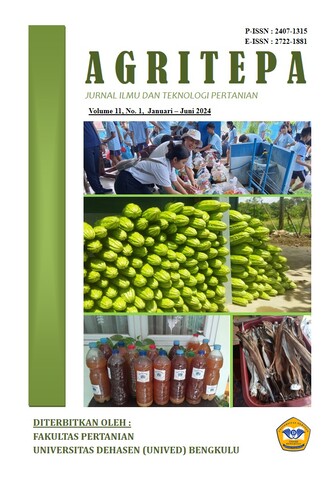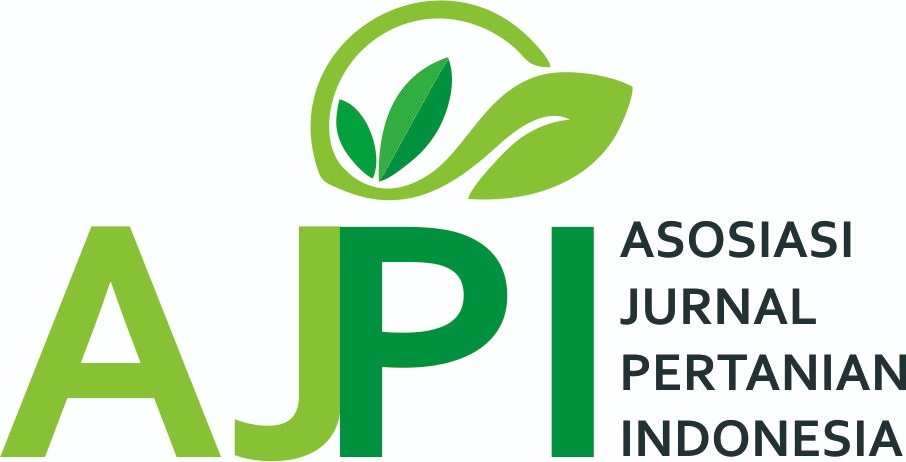Potential of Aqueous Extracts From Root Organs of Ratoon Plants Sorghum Cultivated on Inceptisols Soil as Bioherbicide
Abstract
Purpose: This study aims to determine the best inhibitory effect of water extracts from the ratoon root organs of sorghum plants grown on Inceptisol soil on the germination of test plants. Methodology: The study used a single-factor completely randomized design with four treatments: control, Numbu roots, Super 1 roots, and Suri 4 roots. The experiment units were petri dishes, and the experiment was repeated four times. The bioassay method in petri dishes was applied, with 10 ml of water extract added to each dish, and 25 Vima 1 mung bean seeds were incubated for three days. Results: The water extracts from the ratoon roots of Numbu and Suri 4, as well as all other sorghum ratoon root extracts, significantly inhibited the germination of test plants compared to the control. Findings: Sorghum ratoon root extracts exhibit potent bioherbicidal properties. Novelty: This research provides insights into the allelopathic potential of different sorghum varieties. Originality: The study offers a detailed analysis of the bioherbicidal effects of sorghum ratoon root extracts on seed germination. Conclusions: Water extracts from sorghum ratoon roots, especially Numbu and Suri 4, effectively inhibit test plant germination. Type of Paper: Empirical Research Article
Downloads
References
Ahmad, A., Z., Cheema, A., & Ahamd, R. (2000). Evaluation of sorgaab as natural weed
inhibitor in maize. The J. Anim. Plant Sci. 10: 141-146.
Almaghrabi, O. A. (2012). Control of wild oat (Avena fatua) using some phenolic compounds
I - Germination and some growth parameters. Saudi Journal of Biological Sciences,
(1), 17–24. https://doi.org/10.1016/j.sjbs.2011.07.005
Cutler, H., ,G, Cutler, S., J. (1999). Biologically active natural products: pharmaceuticals. CRC
Press; Jul 27.
Cvikrova, M., Hrubcova, M., Eder, J., & Binarova, P. (1996). Changes in the levels of
endogenous phenolics, aromatic monoamines, phenylalanine ammonia-lyase,
peroxidase, and auxin oxidase activities during initiation of alfalfa embryogenic and
non embryogenic calli. Plant Physiol Biochem 34:853–861
Farooq, M., Habib, M., Wahid, A., & Munir, R. (2011). Employing Aqueous Allelopathic
Extracts of Sunflower in Improving Salinity Tolerance of Rice. Journal of Agriculture
& Social Sciences, 7, 75–80. http://www.fspublishers.org
Javaid, A., Shafique, S., Bajwa, R., & Shafique, S. (2006). Effect of aqueous extracts of
allelopathic crops on germination and growth of Parthenium hysterophorus L. South
African Journal of Botany, 72(4), 609–612. https://doi.org/10.1016/j.sajb.2006.04.006
Little, N. G., Ditommaso, A., Westbrook, A. S., Ketterings, Q. M., & Mohler, C. L. (2021).
Effects of fertility amendments on weed growth and weed-crop competition: A review.
Weed Science, 69(2), 132–146. https://doi.org/10.1017/wsc.2021.1
Macías, F. A., Molinillo, J. M., Varela, R. M., & Galindo, J. C. (2007). Allelopathy a natural
alternative for weed control. Pest Management Science, 3(4), 327-348.
Mustafa G, Ali A, Ali S, Barbanti L, Ahmad M. (2019). Evaluation of dominant allelopathic
weed through examining the allelopathic effects of four weeds on germination and
seedling growth of six crops. Pakistan Journal of Botany. 51(1):269-78.
Muzaffar, S., B. Ali, and N. A. W. (2012). Effect of Catechol , Gallic Acid and Pyrogallic
Acid on the Germination , Seedling Growth and the Level of Endogenous Phenolics.
International Journal of Life Science Biotechnology and Pharma Research, 1(3), 50–
Naby, K. Y., & Ali, K. A. (2020). Effect of sorghum [Sorghum Bicolor (L.) Moench] aqueous
extract on germination and seedling growth of wheat, wild oat, wild barley and canary
grass. Journal of Advanced Pharmacy Education & Research| Apr-Jun, 10(S2), 191.
Patterson, D. T. (1981). Effects of Allelopathic Chemicals on Growth and Physiological
Responses of Soybean ( Glycine max ) . Weed Science, 29(1), 53–59.
https://doi.org/10.1017/s0043174500025820
Sène, M., Doré, T., & Pellissier, F. (2000). Effect Of Phenolic Acids In Soil Under And Seedling Growth of Peanut( Arachis hypogea ). In Situ, 26(3), 625–637.
Kinata, A., Susilo, E., & Pujiwati, H. (2024). Potential of Aqueous Extracts from Root Organs of Ratoon...
p-ISSN : 2407–1315, e-ISSN : 2722-1881 AGRITEPA, Vol.11, No.1, Januari –Juni 2024
AGRITEPA: Jurnal Ilmu dan Teknologi Pertanian, Vol.11 No.1 2024 page: 153 – 164 |163
Susanti, A. T. A., Isda, M. N., & Fatonah, S. (2014). Potensi Alelopati Ekstrak Daun Gleichenia
linearis (Burm.) Underw. Terhadap Perkecambahan Dan Pertumbuhan Anakan Gulma
Mikania micrantha (L.) Kunth. Jom Fmipa, 1(2), 1–7.
Susilo, E., Setyowati, N., Nurjannah, U., Riwandi, & Muktamar, Z. (2021). Effect of Swamp
Irrigation Pattern and Sorghum Extract Concentration on Sorghum Seed Sprout.
Proceedings of the 3rd KOBI Congress, International and National Conferences
(KOBICINC 2020), 14(Kobicinc 2020), 19–25.
https://doi.org/10.2991/absr.k.210621.005
Terzi, I. (2008). Allelopathic effects of Juglone and decomposed walnut leaf juice on
muskmelon and cucumber seed germination and seedling growth. African Journal of
Biotechnology, 7(12), 1870–1874.
Vyvyan, J., R. (2002). Allelochemicals as leads for new herbicides and agrochemicals.
Tetrahedron 58:1631-1646.
Won, O. J., Uddin, M. R., Park, K. W., Pyon, J. Y., & Park, S. U. (2013). Phenolic compounds
in sorghum leaf extracts and their effects on weed control. Allelopathy Journal, 31(1),
–156.
Zarwazi, L. M., Chozin, M. A., & Guntoro, D. D. (2016). Potensi Gangguan Gulma pada Tiga
Sistem Budidaya Padi Sawah. Jurnal Agronomi Indonesia (Indonesian Journal of
Agronomy), 44(2), 147. https://doi.org/10.24831/jai.v44i2.13481
Copyright (c) 2024 Andreani Kinata, Edi Susilo, Hesti Pujiwati (Author)

This work is licensed under a Creative Commons Attribution-ShareAlike 4.0 International License.
Author retains the copyright and grants the journal the right of first publication of the work simultaneously licensed under the Creative Commons Attribution-ShareAlike 4.0 License that allows others to share the work with an acknowledgement of the work's authorship and initial publication in this journal













